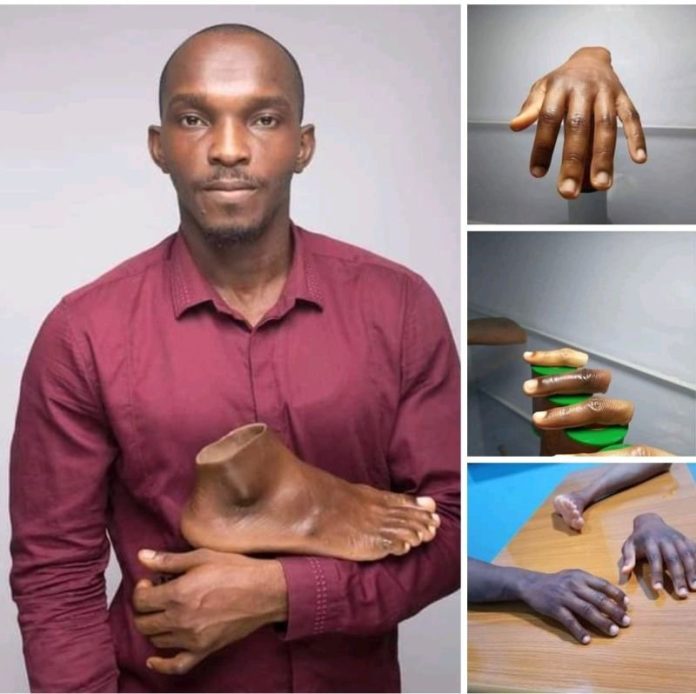Losing a limb or any other body part is a life-altering experience that necessitates significant adjustments to nearly every aspect of daily life. The impact extends beyond physical limitations, as living with a disability can profoundly affect one’s sense of identity, self-esteem, and overall self-perception.
Historically, prosthetics were designed to replace an amputated body part in a comfortable, functional, and cosmetic way. However, the industry has long been criticised for its lack of diversity, with most prosthetic limbs designed to match only white skin tones, and they often fall short in terms of realism.
Recognising this glaring oversight, Nigerian innovator, John Amanam, sought to revolutionise the field by creating more inclusive and realistic prosthetic options. SONIA OKERE reports
Who is John Amanam?
He is said to be the first African artist to create a hyper realistic prosthesis that has the exact skin tone of Africans. By merging artistic flair, technical precision, and empathy, he crafts bespoke prosthetic pieces that not only restore functionality but also celebrate individuality and self-expression.
From hyper-realistic limbs that mimic the natural form to bold, to eye-catching designs that make a statement, John’s work is pushing the boundaries of what’s possible in prosthetic art.
The Akwa Ibom indigene had his secondary school education at the Federal Government College, Ikot Ekpene. He later went to the University of Uyo, Akwa Ibom State, where he obtained a degree in Fine & Industrial Arts.
When you look at my work, you will see veins and nails, and they look almost real
Creating the first realistic prosthesis in Africa
According to reports, John is the first African artist to create a hyper realistic prosthesis that matches the skin tone of Africans. During an interview with the BBC, he mentioned that his journey began many years ago when his brother lost a limb due to an accident. His family ordered a prosthetic, and upon arrival, they were shocked to find that the device did not match his brother’s tone of skin. The mismatch was very conspicuous, making the prosthetic limb appear very artificial. This affected his brother’s self-esteem.
According to John, this experience sparked a turning point for him, and he embarked on a quest to create prosthetic coverings that would harmonise with his brother’s brown skin tone. After undergoing intensive training and exploration, he was able to start his company.
The journey began many years ago when his brother lost a limb due to an accident
Immortal Cosmetic Art
John is the CEO of Immortal Cosmetic Art Ltd., the first African indigenous company to produce hyper-realistic flesh covers for darker races. Unlike others who make products with moderate details, John mentioned that his company is excellent in sculpturing and pays attention to every feature.
“I create flesh covers for people who’ve lost different body parts, ranging from ears, noses, fingers, and breast forms. I have been recognised as the first African man to create hyper real prosthetics, not because there were no prostheses or flesh covers out there.
“When you look at my work, you will see veins and nails, and they look almost real. There’s a difference between something being naturalistic and something being realistic.” He said.
What began as a quest to solve a challenge has, today, become a ground-breaking innovation that is transforming lives and helping those with any form of disability regain their confidence.
I create flesh covers for people who’ve lost different body parts, ranging from ears, noses, fingers, and breasts
Although the company is based in Nigeria, John mentioned that he receives orders from all over the world.
“Within three years, we’ve had at least 400 clients from more than 60 countries and have made worldwide deliveries across the globe. We’ve hosted clients from different countries in our state. We are about to launch a training programme to enable people to reach us from other countries, instead of travelling to Uyo, Akwa Ibom State, Nigeria,” Hhe stated.
Challenges
Every business has its problems that can individually or collectively affect its growth and profitability.
In a recent interview, John shared some of the challenges his company is currently facing.
“One of our biggest challenges is scaling up to meet the high demand for our products. With a limited workforce, we’re struggling to transition from a small company to an industrial-level operation that can supply to multiple African countries.”
As Africans, it’s crucial that we tackle our own problems using our resources and ingenuity
He emphasised the importance of self-sufficiency and local problem-solving, noting, “As Africans, it’s crucial that we tackle our own problems using our resources and ingenuity. When outsiders solve our problems, they often do so with their own interests and profits in mind. But when we solve our own problems, we can create solutions that truly benefit African society.”
In conclusion, Mr. John Amanam is reshaping the future of prosthetics and restoring confidence to those living with disability. His innovative spirit demonstrates the remarkable ability of art to heal, uplift, and transform.


